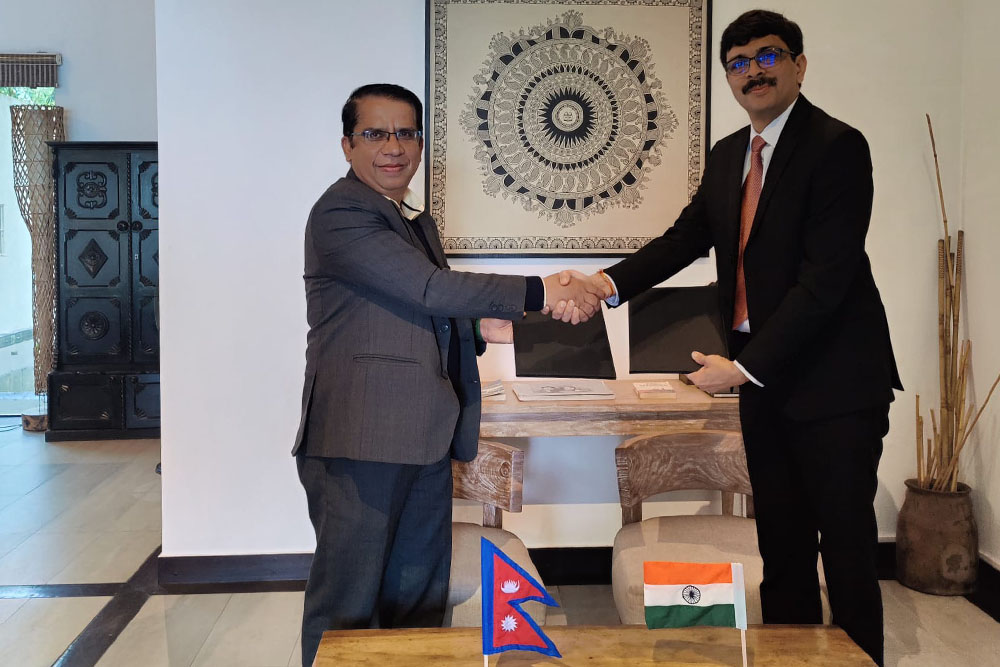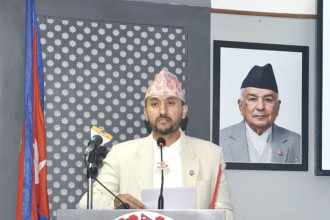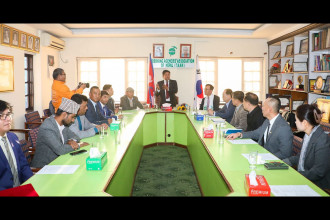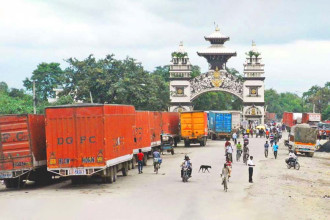
KATHMANDU: Nepal and India have held significant discussions and agreed on eight different topics in the energy sector. The 11th meeting of the Nepal-India Energy Secretary-level Joint Steering Committee, which concluded in Chitwan today, has primarily agreed on the topic of strengthening the electricity transmission system.
Nabin Raj Singh, Joint Secretary at the Ministry of Energy, Water Resources and Irrigation (MoEWRI), stated that the meeting discussed various agendas prepared by the Joint-Secretary-level Joint Taskforce. The meeting was co-chaired by MoEWRI Secretary Gopal Prasad Sigdel, and Indian Ministry of Energy Secretary Pankaj Agrawal.
Prior to this, the 11th meeting of the Nepal-India Energy Joint Taskforce, co-chaired by Joint Secretary Singh and Joint Secretary of India's Ministry of Power, D Saibaba, held necessary discussions on the existing, under-construction, and proposed inter-country power transmission lines, various projects with Indian investment, and related transmission line projects, among other topics. The taskforce meeting also made recommendations to the Secretary-level meeting on these topics after discussing them.
However, it is said that most of the topics agreed upon this time will be finalised by the technical groups, as these agreements are more concerned with technical topics. The meeting made decisions in principle only since most of the topics are more technically related, according to Nepali high officials participating in the meeting.
Both sides have agreed on expanding the capacity of the Dhalkebar-Mujaffarpur Inter-country Transmission Line to 1,000 megawatts (MW). Required infrastructure will be constructed at the Dhalkebar sub-station for this purpose. At present, the export and import of 800MW of electricity is taking place from this transmission line.
The Joint Technical Committee will study and make necessary decisions on the topic of utilising this transmission line to its maximum capacity. Nepal has also been paying the transmission fees for utilising the full capacity of this transmission line.
The high officials of the MoEWRI who attended the meeting said that an important agreement has been made regarding the utilisation of the maximum capacity of the first inter-country transmission line linking Nepal and India.
Similarly, the Joint Technical Committee will also make the necessary decision regarding determining the capacity of electricity that can be transmitted via the Dhalkebar-Sitamarhi 400kV transmission line being constructed by the Indian company SJVN Ltd. The Indian company is constructing this transmission line for exporting electricity to be produced from the Arun III Hydropower Project. This company, which is constructing the Arun-III project, has also taken responsibility for constructing other projects as well. It will take a while until these projects are completed.
Likewise, the meeting has agreed that the Joint Technical Committee will conduct a study on the feasibility of exporting power up to 200MW through the 132kV Tanakpur-Mahendranagar transmission line or other high-voltage capacity transmission lines.
The meeting has approved the process and procedure for electricity export and import between Nepal and India during the monsoon via the existing transmission lines of 132kV capacity or less by using the power transmission system of the neighbouring Indian states. These processes and procedures were prepared by the Central Electricity Authority of India in coordination with the Nepal Electricity Authority (NEA) and other agencies of India.
The meeting has also given the responsibility to the Joint Working Group for the construction of an additional two transmission lines of higher capacity. The 400kV Yanrupa-Purnia transmission line and the New Lamki-Dodhara-Bareli 400 KV transmission line will be constructed between Nepal and India. The objective is to construct these two transmission lines until 2028. The modality of these transmission lines will also be finalised by the Joint Working Group.
The taskforce led by the joint secretaries of the Energy Ministry of the two countries will prepare the necessary modality for this.
Discussions have also been held in principle on having soon a separate tripartite agreement, in accordance with the Power Import and Export Guidelines of India, among NEA, the NTPC Vidhyut Vyapar Nigam of India and the Power Development Board of Bangladesh for the export of 40MW electricity from Nepal to Bangladesh by using India's transmission system.
Based on this discussion, the necessary mechanism will be established for the three-nation partnership. This mechanism will make the necessary decisions, it is said.
These agreements related to transmission line and energy sector were reached in the context of Minister of External Affairs of India, Subrahmanyam Jaishankar's visit to Nepal on January 4 and 5.
The agreement between the governments of Nepal and India on Long Term Power Trade was signed during the visit of India Minister Jaishankar, opening the door for the export of 10,000MW of electricity to India from Nepal in 10 years.
The Minister for Foreign Affairs of Nepal and the Minister of External Affairs of India remotely inaugurated the 132kV cross-border transmission lines between Nepal and India, namely the second circuit of Raxaul-Parwanipur line, the second circuit of Kataiya-Kusaha line and the New Nautanwa-Mainhiya lines.
By RSS
READ ALSO:
- Electricity export agreement a milestone in power trade: PM Dahal
- Nepal, India sign four agreements relating to network expansion, trade, water resources, power trade
- Nepal, India ink agreement on electricity trade






